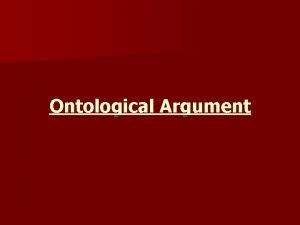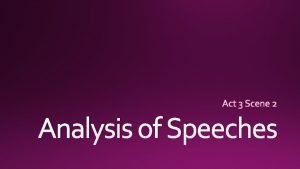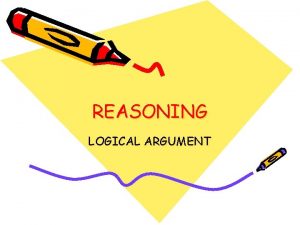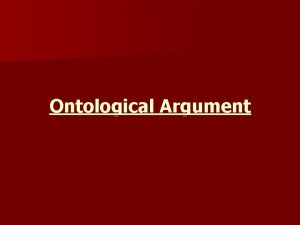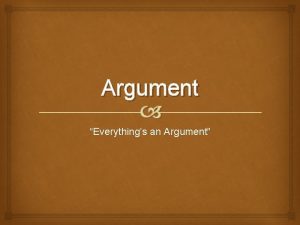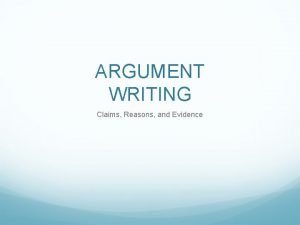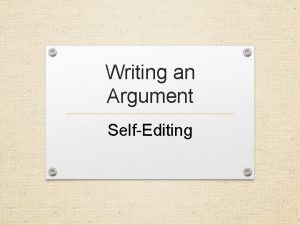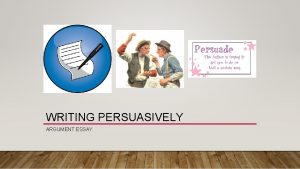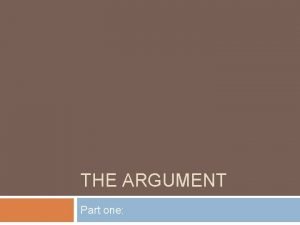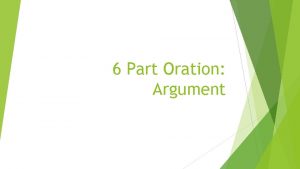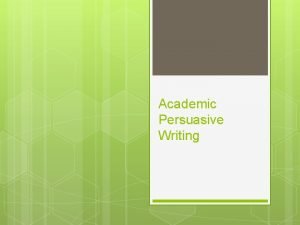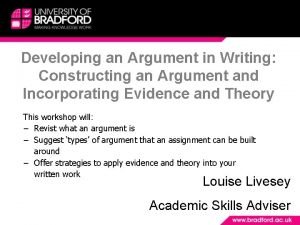Writing Part 4 Argument Writing ArgumentationOpinion The writing




















- Slides: 20

Writing Part 4: Argument Writing

Argumentation/Opinion • The writing tasks for argument ask the student to support or oppose a claim or position on a given issue arising from interpersonal, school/community, or social contexts. • Used for many purposes -To change the reader’s point of view -To bring about some action on the reader’s part -To ask the reader to accept the writer’s explanation or evaluation of a concept, issue or problem. • An argument is a reasoned, logical way of demonstrating that the writer’s position, belief, or conclusion is.

SAMPLE ARGUMENT WRITING PROMPT GRADES 6 -8 WRITING SITUATION Education researchers claim that student learning will improve if all printed textbooks are replaced with electronic textbooks, known as e-textbooks. Based on the researchers’ findings, students in your school will be issued an e-textbook reader, which is a device that displays electronic books. WRITING TASK Write an essay either supporting or opposing the claim that student learning will improve if all student textbooks are replaced with electronic reading books. Use your knowledge and your own experience or observation to develop your essay. Use reasons, facts, examples and/or other evidence to support your position.

General Characteristics: Argument Writing • Thesis states a narrowed and defined argument • Is text- and research-based • Evidence to support reasoning and position is clearly and accurately written • Refutes opposing arguments • Has a conclusion • Restates premise and summarizes

Argument vs. Persuasion • When writing to persuade, writers employ a variety of persuasive strategies -Appeals to the credibility, character, or authority of the writer (or speaker)—when writers establish that they are knowledgeable and trustworthy, audiences are more likely to believe what they say -Appeals to the audience’s self-interest, sense of identity, or emotions, any of which can sway an audience -Persuasive writing never acknowledges that there is another side to the argument.

Argument vs. Persuasion • A logical argument, on the other hand, convinces the audience because of perceived merit and reasonableness of the claims and proofs offered rather than either the emotions the writing evokes in the audience or the character or credentials of the writer • The standards place special emphasis on writing logical arguments as a particularly important form of college- and career-ready writing • In summation, persuasive writing is not as rigorous because it allows students to write solely based on their experiences and emotions, without having to gather evidence and facts or consider the other side.

The Argument Essay Checklist (√) Remember……The argumentative essay, while similar to the persuasive essay, also has a few differences; most importantly, the argumentative essay uses evidence to both show one’s own position and to refute the opposing argument. One way to organize this kind of essay is what we call the claim and counter-claim format. You should try to write at least five paragraphs for the argument essay: √ √ Start by introducing the topic and state or explain your position. Then use one paragraph to state each of your points (supporting reasons), following your statement with the evidence (facts/examples) that proves or supports your points. You should try to have a minimum of 3 supporting reasons/paragraphs. Then follow your supporting reasons with at least one paragraph with an opposing view (opposing claim) and evidence that supports the objection. In this paragraph, you should also rebut your counter claim(s) (counter point) and its/their evidence (response to opposing claim). Conclusion: restate your claim or position; include a summary of supporting points, and an assessment of rebuttals

Argument Map • Introduce your claim (Be sure to state the topic) • Supporting reason 1: Evidence (facts or examples) to support reason 1: • Supporting reason 2: Evidence (facts or examples) to support reason 2: • Supporting reason 3: Evidence (facts or examples) to support reason 3: • Opposing claim: Response to opposing claim: • Conclusion

Argument Essay Claim & Counter Claim

Remember…. . • The argument essay, while similar to the persuasive essay, also has a few important differences:

The Argument Essay • Most importantly, the argument essay uses evidence to both show one’s own position and to refute the opposing argument.

The Argument Essay CLAIM • One way to organize this kind of essay is what we call the claim… Counter. Claim • …and the counter-claim format.

The Beginning Start by introducing the topic and state or explain your position.

• Then use one paragraph to state each of your points, following your statement with the evidence that proves or supports your points.

Then follow each point with an opposing view and evidence that supports the objections. Use one paragraph for each counter point. Also, be sure to respond to each opposing claim (rebuttal)

Finally. . Use one paragraph to sum-up what you have written.

In Conclusion: Restate your claim or position; include a summary of supporting points, and an assessment of rebuttals.

Argument Essay Model: Should schools stop serving chocolate milk to their students? Schools should keep serving chocolate milk. There should be chocolate milk because kids like it, it gives vitamins, and it gets kids in good habits. Many kids love chocolate milk – it makes them happy to see it in the cafeteria, their lunch box, at their kitchen table. Research shows that, overall, chocolate milk is pretty good for kids. It’s especially important that kids like chocolate milk. It turns out that more kids drink milk, when they can get chocolate milk. When you interview a lot of parents, like Katie Couric did, they’ll say that their kids only drink milk if they can get chocolate milk. So at least they’re drinking milk. In a survey of students in this school, 84% said that they would drink more milk if they had chocolate milk available. Of those same students, 28% said that they wouldn’t drink any milk at all unless it were chocolate.

Surprisingly, chocolate milk turns out to have vitamins. A nutritionist from the Dairy Association, demonstrates that chocolate milk is a good source of vitamin A, D, E, and calcium. That’s a lot of vitamins and they’re in something kids actually like to drink! In her information session, the nutritionist is with kids who drink chocolate milk. Their bright teeth and glossy hair illustrates that kids who love chocolate milk will be that healthy. There’s one more reason why chocolate milk should be served in schools. The famous nutrionist argued that chocolate milk has a lot less sugar and carbohydrates than soda and power drinks like Gatorade. So if kids get in the habit of drinking milk in school, then they’ll probably skip the sodas outside of school. The chocolate milk that is served in our school, for instance, is low fat. So it is a lot better for kids than soda. It’s true that Jamie Oliver, a chef and enemy of chocolate milk, argued that chocolate milk does have added sugar. Jamie is a famous English chef who is involved with lunch for kids in schools in Los Angeles. In a shocking video, Jamie shows a school bus filled with sugar to show much sugar school kids get from chocolate milk. But there a lot of school kids in the US, and if you divide that busload up between all the kids, it will not be such a shocking amount. And if you put next to it a bus filled with the vitamins A, D, E and calcium that kids get, the picture might seem very different.

That’s why we should keep serving chocolate milk at school – it gets kids to drink milk, it gives them vitamins, and it builds good habits. Personal, insider experience supports this claim. As a seventh grader, this investigator was part of an experiment to ban chocolate milk in his cafeteria. Seventh graders, though, are allowed to go out for lunch. With no chocolate milk, this luncheon seeker started going out for pizza and coke. Gone were all the vitamins and calcium. Jamie Oliver doesn’t necessarily know what happens inside schools. When something is taken away at lunch that is even a little good for you, it’s not always replaced by something better, or anything at all. In fact, the vitamins from chocolate milk may possibly be the only ones some kids get in school lunch. So keep chocolate milk, kids’ main source of vitamins, good habits, and happiness.
 Anselm argument for god
Anselm argument for god Hình ảnh bộ gõ cơ thể búng tay
Hình ảnh bộ gõ cơ thể búng tay Bổ thể
Bổ thể Tỉ lệ cơ thể trẻ em
Tỉ lệ cơ thể trẻ em Voi kéo gỗ như thế nào
Voi kéo gỗ như thế nào Tư thế worm breton là gì
Tư thế worm breton là gì Chúa yêu trần thế alleluia
Chúa yêu trần thế alleluia Các môn thể thao bắt đầu bằng tiếng bóng
Các môn thể thao bắt đầu bằng tiếng bóng Thế nào là hệ số cao nhất
Thế nào là hệ số cao nhất Các châu lục và đại dương trên thế giới
Các châu lục và đại dương trên thế giới Công thức tính độ biến thiên đông lượng
Công thức tính độ biến thiên đông lượng Trời xanh đây là của chúng ta thể thơ
Trời xanh đây là của chúng ta thể thơ Mật thư anh em như thể tay chân
Mật thư anh em như thể tay chân Phép trừ bù
Phép trừ bù Phản ứng thế ankan
Phản ứng thế ankan Các châu lục và đại dương trên thế giới
Các châu lục và đại dương trên thế giới Thể thơ truyền thống
Thể thơ truyền thống Quá trình desamine hóa có thể tạo ra
Quá trình desamine hóa có thể tạo ra Một số thể thơ truyền thống
Một số thể thơ truyền thống Cái miệng xinh xinh thế chỉ nói điều hay thôi
Cái miệng xinh xinh thế chỉ nói điều hay thôi
